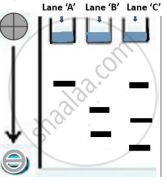Advertisements
Advertisements
प्रश्न
Describe Meselson and Stahl’s experiment that was carried in 1958 on E.Coli. Write the conclusion they arrived at after the experiment.
उत्तर
Experiment
The experiment was performed by Meselson and Stahl. The following steps were
followed in the experiment:
(i) E. coli was grown in a medium containing the heavy isotope 15N as the sole nitrogen source.
(ii) This led to the incorporation of 15N into the newly synthesised DNA, which ultimately made the DNA heavy.
(iii) This heavy DNA was separated from the normal DNA by density gradient centrifugation using caesium chloride as the gradient.
(iv) The cells were then transferred into a medium with 14N as the nitrogen source.
(v) Samples were taken from this medium and the DNA was extracted.
Observation
Because E. coli divides every 20 minutes, the DNA extracted after 20 minutes in the experiment had a hybrid density. DNA extracted after 40 minutes had equal amounts of hybrid and light densities.
Conclusion
This implies that the newly synthesised DNA obtained one of its strands from the parent. Thus, replication was semi-conservative.

APPEARS IN
संबंधित प्रश्न
Describe the experiment that helped demonstrate the semi-conservative mode of DNA replication.
How was a heavy isotope of nitrogen used to provide experimental evidence to semi-conservative mode of DNA-replication ?
Which of the following is correct for Watson and Crick’s model of DNA. It is duplex with ______.
DNA replication is ______.
First experimental proof for semi-conservative DNA replication was shown in ______.
DNA replication takes place at ______ phase of the cell.
In order to form a dinucleotide during DNA synthesis which functional group at 3' must be free?
In which type of DNA replication of the two newly formed molecules, one is purely a new one and the other one is old?
Discuss the significance of heavy isotope of nitrogen in the Meselson and Stahl’s experiment.
The DNA molecules of the same size were extracted from E. coli and Plasmodium vivax. It was discovered that both the DNA molecules had one target site each for the restriction enzyme Hind II. After being digested with Hind II, the DNA fragments were subjected to gel electrophoresis.
With reference to the diagram given below, identify the lanes that represent the DNA fragments of E. coli and Plasmodium vivax respectively. Justify your answer with a reason for each.

